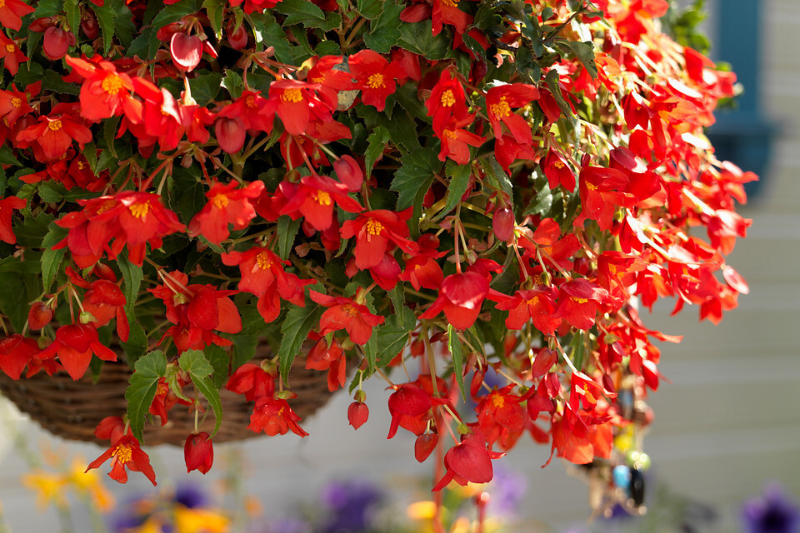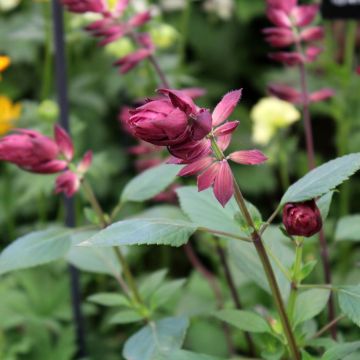

Pétunia Tumbelina Anna double rose et blanc
Petunia Tumbelina Anna
Petunia x hybrida Tumbelina Anna
Garden Petunia, Common Petunia
The plug plants grew well. There was a beautiful flowering from late May to early July, but then, nothing more, while the other surfinias bloomed well in the same planters. Disappointing, I do not recommend!
JPierre, 07/08/2024
Special offer!
Receive a €20 voucher for any order over €90 (excluding delivery costs, credit notes, and plastic-free options)!
1- Add your favorite plants to your cart.
2- Once you have reached €90, confirm your order (you can even choose the delivery date!).
3- As soon as your order is shipped, you will receive an email containing your voucher code, valid for 3 months (90 days).
Your voucher is unique and can only be used once, for any order with a minimum value of €20, excluding delivery costs.
Can be combined with other current offers, non-divisible and non-refundable.
Home or relay delivery (depending on size and destination)
Schedule delivery date,
and select date in basket
This plant carries a 6 months recovery warranty
More information
We guarantee the quality of our plants for a full growing cycle, and will replace at our expense any plant that fails to recover under normal climatic and planting conditions.

Would this plant suit my garden?
Set up your Plantfit profile →
Description
The Petunia 'Tumbelina Anna' is a recent variety with double and beautifully bicoloured flowers, in pink and white, which also has good tolerance to bad weather and a very pleasant fragrance. The dense and semi-trailing habit and the endless flowering of this generous annual plant will work wonders in flower pots and hanging baskets. Each fringed petal is regularly bordered in white on a background of striking pink. A petunia that makes a big impact!
Hybrid petunias all come from several plants native to the warm regions of South America. The chance discovery of trailing petunias occurred in 1989 when a scientist noticed a particularly vigorous wild petunia covered in bright flowers on the edge of a field: the Petunia inflata. Crossed with others, this species gave rise to trailing petunias, which were given the marketing name Surfinias. The semi-trailing 'Tumbelina Anna' petunia belongs to the solanaceae family and is closely related to ornamental tobacco, for example, its foliage also contains alkaloids. This plant rapidly forms a dense dome-shaped clump, slightly spreading, wider than tall, 30 cm (12in) in height and 50 cm (20in) in diameter. It produces hundreds of flowers from June until the first night frosts, provided it is regularly supplied with fertilizer. Its flowers are large, unique, shiny and gently scented. The foliage, quite pubescent, has entire margins and a dark green colour.
No other flowering annual plant has undergone such extensive selection work by breeders for over a century. The results are impressive, as petunias rival geraniums in the splendor and length of their flowering, as demonstrated by this variety. Plant it in large pots or hanging baskets, above walls, wherever its flower-covered stems can cascade down. 5 identical or mixed colour plants are enough to fill a large flower box. You can also plant them in beds, in large swathes, to punctuate gray foliage borders like cerastiums or artemisias, or to cover the base of roses.
Note: Attention, our young plug plants are professional products reserved for experienced gardeners: upon receipt, transplant and store them under cover (veranda, greenhouse, cold frame) at a temperature above 14°C (57.2°F) for a few weeks before being installed outdoors once the risk of frost is definitively eliminated.
Petunia Tumbelina Anna in pictures


Flowering
Foliage
Plant habit
Botanical data
Petunia
x hybrida
Tumbelina Anna
Solanaceae
Garden Petunia, Common Petunia
Cultivar or hybrid
Other Petunia and Surfinia
View all →Planting and care
You can plant your petunias in open ground or in pots. If you wish to install them in open ground, wait until the last heavy frosts have passed (surfinia petunias tolerate a small late frost). In the meantime, you can pre-grow them in a pot in a warm and bright place to accelerate their growth. Petunias will bloom from June to October. Plant your petunias in a sunny or semi-shaded position sheltered from the wind. They need a light and humus-rich but above all well-draining soil. Do not water them too much at the beginning of the growing season as they are sensitive to excess moisture. They tolerate drought well, but will need regular watering during hot summer weather. Petunias are sensitive to frost (minimum -1°C (30.2°F)). Very floriferous and fast-growing, they are hungry plants. We recommend feeding them with a liquid fertilizer for surfinias once or twice a week during the growing season. Remove faded flowers and dry leaves as they appear to keep them looking beautiful and prolong flowering.
Planting period
Intended location
Care
Planting & care advice
-
, onOrder confirmed
Reply from on Promesse de fleurs
Similar products
Haven't found what you were looking for?
Hardiness is the lowest winter temperature a plant can endure without suffering serious damage or even dying. However, hardiness is affected by location (a sheltered area, such as a patio), protection (winter cover) and soil type (hardiness is improved by well-drained soil).

Photo Sharing Terms & Conditions
In order to encourage gardeners to interact and share their experiences, Promesse de fleurs offers various media enabling content to be uploaded onto its Site - in particular via the ‘Photo sharing’ module.
The User agrees to refrain from:
- Posting any content that is illegal, prejudicial, insulting, racist, inciteful to hatred, revisionist, contrary to public decency, that infringes on privacy or on the privacy rights of third parties, in particular the publicity rights of persons and goods, intellectual property rights, or the right to privacy.
- Submitting content on behalf of a third party;
- Impersonate the identity of a third party and/or publish any personal information about a third party;
In general, the User undertakes to refrain from any unethical behaviour.
All Content (in particular text, comments, files, images, photos, videos, creative works, etc.), which may be subject to property or intellectual property rights, image or other private rights, shall remain the property of the User, subject to the limited rights granted by the terms of the licence granted by Promesse de fleurs as stated below. Users are at liberty to publish or not to publish such Content on the Site, notably via the ‘Photo Sharing’ facility, and accept that this Content shall be made public and freely accessible, notably on the Internet.
Users further acknowledge, undertake to have ,and guarantee that they hold all necessary rights and permissions to publish such material on the Site, in particular with regard to the legislation in force pertaining to any privacy, property, intellectual property, image, or contractual rights, or rights of any other nature. By publishing such Content on the Site, Users acknowledge accepting full liability as publishers of the Content within the meaning of the law, and grant Promesse de fleurs, free of charge, an inclusive, worldwide licence for the said Content for the entire duration of its publication, including all reproduction, representation, up/downloading, displaying, performing, transmission, and storage rights.
Users also grant permission for their name to be linked to the Content and accept that this link may not always be made available.
By engaging in posting material, Users consent to their Content becoming automatically accessible on the Internet, in particular on other sites and/or blogs and/or web pages of the Promesse de fleurs site, including in particular social pages and the Promesse de fleurs catalogue.
Users may secure the removal of entrusted content free of charge by issuing a simple request via our contact form.
The flowering period indicated on our website applies to countries and regions located in USDA zone 8 (France, the United Kingdom, Ireland, the Netherlands, etc.)
It will vary according to where you live:
- In zones 9 to 10 (Italy, Spain, Greece, etc.), flowering will occur about 2 to 4 weeks earlier.
- In zones 6 to 7 (Germany, Poland, Slovenia, and lower mountainous regions), flowering will be delayed by 2 to 3 weeks.
- In zone 5 (Central Europe, Scandinavia), blooming will be delayed by 3 to 5 weeks.
In temperate climates, pruning of spring-flowering shrubs (forsythia, spireas, etc.) should be done just after flowering.
Pruning of summer-flowering shrubs (Indian Lilac, Perovskia, etc.) can be done in winter or spring.
In cold regions as well as with frost-sensitive plants, avoid pruning too early when severe frosts may still occur.
The planting period indicated on our website applies to countries and regions located in USDA zone 8 (France, United Kingdom, Ireland, Netherlands).
It will vary according to where you live:
- In Mediterranean zones (Marseille, Madrid, Milan, etc.), autumn and winter are the best planting periods.
- In continental zones (Strasbourg, Munich, Vienna, etc.), delay planting by 2 to 3 weeks in spring and bring it forward by 2 to 4 weeks in autumn.
- In mountainous regions (the Alps, Pyrenees, Carpathians, etc.), it is best to plant in late spring (May-June) or late summer (August-September).
The harvesting period indicated on our website applies to countries and regions in USDA zone 8 (France, England, Ireland, the Netherlands).
In colder areas (Scandinavia, Poland, Austria...) fruit and vegetable harvests are likely to be delayed by 3-4 weeks.
In warmer areas (Italy, Spain, Greece, etc.), harvesting will probably take place earlier, depending on weather conditions.
The sowing periods indicated on our website apply to countries and regions within USDA Zone 8 (France, UK, Ireland, Netherlands).
In colder areas (Scandinavia, Poland, Austria...), delay any outdoor sowing by 3-4 weeks, or sow under glass.
In warmer climes (Italy, Spain, Greece, etc.), bring outdoor sowing forward by a few weeks.



















































